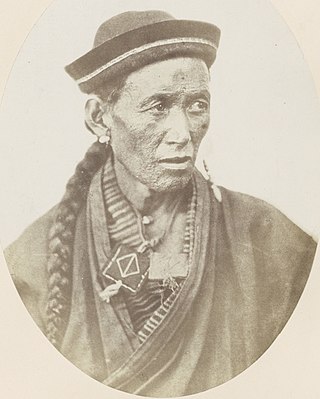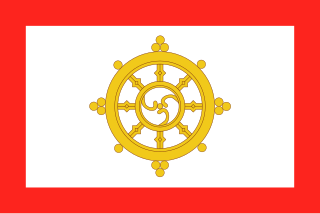Electoral history
| Election | Seats won | Seats +/- | Source |
|---|---|---|---|
| 1953 | 6 / 18 | - | [4] |
| 1958 | 7 / 20 | ||
| 1967 | 2 / 24 | ||
| 1970 | 4 / 24 | [5] | |
Sikkim State Congress | |
|---|---|
| Founded | 1947 |
| Dissolved | 1972 |
| Merged into | Sikkim Janata Congress |
| Ideology | Abolishment of Landlordism, One Man One Vote, Annexation of Kingdom of Sikkim with India |
| Colours | Blue |
The Sikkim State Congress, or SSC, was an annexationist political party in the Kingdom of Sikkim. It was founded in 1947 and worked closely with the Indian National Congress (INC) to successfully achieve the annexation of Sikkim to India. Other parties established by the INC to serve India's interests in its near abroad included the Nepal State Congress Party and the Bhutan State Congress Party.
Sikkim State Congress was formed on 7th December 1947 after localised organisations Praja Sudharak Samaj, Praja Sammelan and Praja Mandal jointly decided to form a unified party. Tashi Tshering was the President of the newly formed party. The SSC's main constituents were Nepalese, while its opponent, the Sikkim National Party, had support among the Bhutia and Lepcha people. It campaigned to change the election system from a confessional system to a "one man, one vote" system. When that reform happened in 1974, the numerically superior Nepalese made the Congress Sikkim's dominant political party. Some anti-clerical and other modernizing elites within the Bhutia-Lepcha community joined the Sikkim State Congress, because of its desire to abolish landlordism. Kazi Lhendup Dorjee, one of these, was president of the party between 1953 and 1958. [1]
Tashi Tshering, Gobardhan Pradhan, DB Tiwari, CD Rai, DS Lepcha, Sonam Tshering, LD Kazi, Roy Choudhary and Helen Lepcha are among the founder members of the party. Tashi Tshering, Kashiraj Pradhan, Nahakul Pradhan and Chandra Das Rai were other prominent leaders who have led the party before the merger with India.
After the formation of the Congress, Tshering organised its first public meeting in 7 December 1947 at Gangtok demanding abolishing landlordism, forming an interim government and accession to India. The Congress started fresh agitation in February,1949 demanding the formation of an interim government and democratic reforms following which Chandra Das Rai and five others were arrested. This was followed by Congress supporters encircling the Palace on 1 May, 1949. On 8 May 1949, Chogyal appointed Sikkim's first interim government led by Chief Minister Tashi Tshering and his popular ministry. However the government was dismissed within 29 days by the Indian Political Officer Harishwar Dayal. [2]
By late 1950s to the 1970s the party was led by Kashiraj Pradhan and his nephew Nahakul Pradhan, both serving as President of the party in different decades. Under their leadership the party greatly moderated it’s anti-Chogyal stand and participated in the Royal Sikkimese administration through subsequent wins in elections to the State Council. By the early 1970s, Nahakul Pradhan led party demanded for a responsible government under the Chogyal opposing the demands of Kazi Lhendup Dorjee led Sikkim National Congress. [3] The party was part of Sikkimese administration throughout the pre merger period with subsequent wins in all elections to the State council. Later SSC merged with Sikkim Janata Party in 1972, forming the Sikkim Janata Congress.
| Election | Seats won | Seats +/- | Source |
|---|---|---|---|
| 1953 | 6 / 18 | - | [4] |
| 1958 | 7 / 20 | ||
| 1967 | 2 / 24 | ||
| 1970 | 4 / 24 | [5] | |

The Bhutia are a community of Sikkimese people living in the state of Sikkim in northeastern India, who speak Drenjongke or Sikkimese, a Tibetic language fairly mutually intelligible with standard Tibetan. In 2001, the Bhutia numbered around 60,300. Bhutia here refers to people of Tibetic ancestry.

The history of Sikkim begins with the indigenous Lepcha's contact with early Tibetan settlers. Historically, Sikkim was a sovereign Monarchical State in the eastern Himalayas. Later a protectorate of India followed by a merger with India and official recognition as a state of India. Lepchas were the main inhabitants as well as the Ruler of the land up to 1641. Lepchas are generally considered to be the first people, indigenous to Sikkim also includes Darjeeling.

Sikkim Himali Rajya Parishad, was a political party in the Indian state of Sikkim. The party president was Dr. A.D. Subba. Tara Shrestha was the general secretary of the party.

Kazi Lhendup Dorjee, also spelled Lhendup Dorji or Lhendup Dorji Khangsarpa was an Indian politician who was the 1st chief minister of Sikkim from 1975 to 1979 after its union with India. He was the 1st Prime Minister of Sikkim from 1974 to 1975. He also served as the Executive Council of Sikkim from 1967 to 1970. He was a member of INC after 1975 and Sikkim National Congress before 1975.

Sikkimese are people who inhabit the Indian state of Sikkim. The dominance ethnic diversity of Sikkim is represented by 'Lho-Mon-Tsong-Tsum' that identifies origin of three races since seventeenth century. The term 'Lho' refers to Bhutias (Lhopo) means south who migrated from Southern Tibet, the term 'Mon' refers to Lepchas (Rong) lived in lower Eastern Himalayas and the term 'Tsong' refers to Limbus, another tribe of Sikkim. The pre-theocratic phase of Sikkim was inhabited by the Kiratis, “Sikkim is also known as the home of the Kirati tribesmen from the pre-historic times.Society in Sikkim is characterised by multiple ethnicity and possesses attributes of a plural society. The present population of Sikkim is composed of different races and ethnic groups, viz., the Lepchas, the Bhutias, the Nepalis and the Plainsmen, who came and settled in different phases of history. The historic 8 May agreement between Chogyal, Government of India and political parties of Sikkim defines Sikkimese as Sikkimese of Bhutia-Lepcha origin or Sikkimese of Nepali origin including Tsongs and Schedule castes. The community in Sikkim is inclusive of three sub-cultural sectors: the Kiratis, the Newaris and the Indian Gorkhas.

The Kingdom of Sikkim, officially Dremoshong until the 1800s, was a hereditary monarchy in the Eastern Himalayas which existed from 1642 to 16 May 1975, then it was merged with the Republic of India. It was ruled by Chogyals of the Namgyal dynasty.
The indigenous people of Sikkim are the Lepchas; the naturalized ethnic populations of Limbus, Bhutias, Kiratis, immigrants such as Indian Gorkha of Nepalese descendants who have an enduring presence in shaping the history of modern Sikkim. The indigeneity criteria for including all peoples of Sikkim and Darjeeling hills is a misnomer as it is clearly known that Lepchas are the first people who trace their origin and culture of their ethnogenesis to the historical and somewhat political geography of Sikkim history as is well documented by colonial and immigrant settler history. However many tribes preceded the migration of the colonial powers and can trace their migratory background as well as ancestral heritage and a well formed history of civilization and cultural locus that is not inherently indigenous to Sikkim.

The Sikkim Legislative Assembly is the unicameral state legislature of Sikkim state in north-eastern India. The seat of the Legislative Assembly is at Gangtok, the capital of the Sikkim state.
General elections were held in Sikkim in May 1953. The Sikkim National Party and the Sikkim State Congress both won six seats. Voter turnout was less than 30%.
Bhim Bahadur Gurung was the third Chief Minister of Sikkim. He held office from 11 May until 24 May 1984, the shortest term in the history of Sikkim.
General elections were held in Sikkim in January 1973. The Sikkim National Party emerged as the largest party, winning nine of the 18 elected seats.
General elections were held in Sikkim on 13 April 1974. They were the first elections in Sikkim to be held on the basis of universal suffrage, and also the last as an independent country. The result was a victory for the Sikkim National Congress, which won 31 of the 32 seats in the State Council. Kazi Lhendup Dorjee subsequently became Chief Minister. In May 1975 Sikkim became a state of India, at which point the State Council became the Sikkim Legislative Assembly.
Athup Lepcha is an Indian politician and environmental activist. He is the vice president of Hamro Sikkim Party (HSP) and the president of "Affected Citizens of Teesta" (ACT), Non-governmental organization for environment and biodiversity.
Kashiraj Pradhan popularly known as Kashi Babu was an Indian pre-merger politician and journalist in Sikkim. He was the President of Sikkim State Congress party, a member of the Sikkim State Council and Executive Council of Sikkim serving multiple terms in office. Known as the Father of Sikkimese journalism, he was the founder and publisher of Sikkim’s first news magazine Kanchenjunga.

Nahakul Pradhan also known as Nakul Pradhan was a Sikkimese pre-merger politician, pro-democracy leader, a member of the Sikkim State Council and Executive Council of Sikkim serving multiple terms. He was the President of the Sikkim State Congress party and the Editor of Sikkim’s first news magazine Kanchenjunga.

Chandra Das Rai popularly known as C.D Rai was a politician of pre merger Sikkim, bureaucrat and former journalist. He was a senior leader in Sikkim State Congress.
Bhuta-Lepcha is an ethnic grouping consisting of people of the Bhutia and Lepcha communities in Sikkim, India. Both these groups are listed as Scheduled Tribes by the Government of India.

The State Council of Sikkim was the legislative body of the erstwhile Kingdom of Sikkim, which was located in the Himalayas, between India and China.
Kazis and Thikadars of Sikkim also known as Ilakadars were the hereditary feudal lords and the ruling class in former Kingdom of Sikkim. They had administrative and judicial powers within their respective land estates. This system existed since the establishment of the Namgyal dynasty and was further institutionalised under the period of British influence in Sikkim.
Tashi Tshering was the first Chief Minister in erstwhile Kingdom of Sikkim from 8 May 1949 to 6 June 1949. He was the President of Sikkim State Congress.